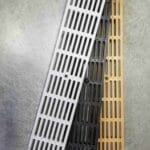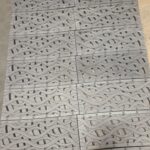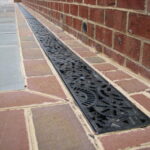Hydraulic design of a trench drain can be quite complex depending on how accurate you need the calculations. The most accurate method is to utilize differential equations to calculate the input along the trench run length and properly verify the flow rates at all depths of the trench. This is very difficult by hand, but most licensed civil engineers can properly model this for you using HEC-RAS. This software was created by the US government and can model complex trench drain applications.
For most projects it is sufficient to utilize Manning’s equation for open channel flow to determine the trench capacity (ie. required flow and size the trench). You must first calculate the flow rate to be captured by the channel drain system. For indoor applications this is generally determined by the process equipment flow rates, wash down hoses, dumping containers, etc. For exterior applications it is dependent on the rainfall of the area. Exterior applications are generally calculated as follows:
Qr = C*I*A
Where:
C is a constant that relates to the surface the drain is installed in (ex. for rigid pavement use 0.9)
I is the rainfall intensity of the design storm (ex. in the south this can be as much as 8 or 9 inches per hour, in the northern united states it is closer to 4 or 5 inches per hour)
A is the drainage area in acres (ex. take the length in feet times the width in feet and then divide by 43560 to convert square feet into acres)
When you multiply these factors together you get the design flowrate (Qr = Q required) of the drain in CFS (cubic feet per second)
Now it is time to calculate the channel flow capacity to determine what size trench may be required for your application.
Qc = A*(1.49/n)*(R)^2/3*(S)^1/2
Where:
A is the cross sectional area of the trench drain in square feet
n is the coefficient of friction of the trench drain body (concrete forming systems = 0.013, polymer concrete systems 0.010, fiberglass & GFRPC systems 0.009)
R is the hydraulic radius which is calculated by A / P where A is the cross sectional area found above and P is the perimeter surface of the trench
S is the slope of the bottom of the trench (be sure to add the site slope and the built in slope of the trench drain system together to get the total effective slope – ex. site slope is 0.5% and trench slope is 1% therefore the total slope is 1.5% or 0.015)








